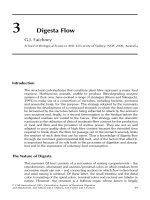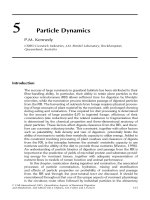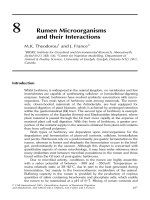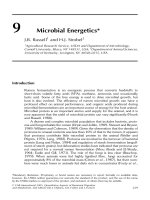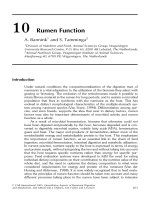Tài liệu Quantitative aspects of ruminant digestion and metabolism - Phần 8 docx
Bạn đang xem bản rút gọn của tài liệu. Xem và tải ngay bản đầy đủ của tài liệu tại đây (279.21 KB, 28 trang )
10
Rumen Function
A. Bannink
1
and S. Tamminga
2
1
Division of Nutrition and Food, Animal Sciences Group, Wageningen
University Research Centre, P.O. Box 65, 8200 AB Lelystad, The Netherlands;
2
Animal Nutrition Group, Wageningen Institute of Animal Sciences,
Marijkeweg 40, 6709 PG Wageningen, The Netherlands
Introduction
Under natural conditions the compartmentalization of the digestive tract of
ruminants is a vital adaptation to the utilization of the biomass they select with
grazing or browsing. The evolution of the reticulorumen made it possible to
retain fibrous material in the rumen for long periods, and to sustain a microbial
population that lives in symbiosis with the ruminant as the host. This has
evolved in distinct morphological characteristics of the multiple-stomach sys-
tem among ruminant species (Van Soest, 1994). Differentiation among spe-
cies, and even breeds, supports the idea that next to dietary factors, rumen
factors may also be important determinants of microbial activity and rumen
function as a whole.
As a result of microbial fermentation, biomass that otherwise could not
have been digested enzymatically by the host, becomes degraded and is con-
verted to digestible microbial matter, volatile fatty acids (VFA), fermentation
gases and heat. The major end-products of fermentation deliver most of the
metabolizable energy and metabolizable protein to the host. This emphasizes
the importance of rumen function, as an essential link in the chain of feed
ingestion, microbial fermentation, intestinal digestion and metabolic utilization.
In current practice, nutrient supply to the host is expressed in terms of energy
and protein supply, without integrating the two and without taking into account
that the host requires specific nutrients rather than energy for specific pur-
poses. Feed evaluation systems were developed to fulfil the need for rating
individual dietary components on their contribution to the nutritive value of the
whole diet, and the need to optimize the dietary composition to what were
considered requirements for energy and protein of the ruminant (Van der
Honing and Alderman, 1988). It is now widely recognized that in feed evalu-
ation the principles of rumen function should be taken into account and many
different processes taking place in the rumen have been subject to intensive
ß CAB International 2005. Quantitative Aspects of Ruminant Digestion
and Metabolism, 2nd edition (eds J. Dijkstra, J.M. Forbes and J. France)
263
investigations for several decades. Attempts have been made to incorporate all
the information gathered in integrated models, in order to understand the
effects of dietary treatments on rumen function as a whole and the conse-
quences for nutrient supply to the host. From several reviews (Baldwin, 1995;
Dijkstra et al., 1996; Bannink and de Visser, 1997; Bannink et al., 1997;
Dijkstra and Bannink, 2000), it becomes apparent what mechanisms have to
be included in such models to obtain an understanding of rumen function.
As a simplified approach, the rumen can be considered to behave as a
continuous fermentor in steady state, and rumen function can be represented
as a set of pools in which fluxes are described mathematically with a set of mass
action and Michaelis–Menten type of equations. Inputs are feed intake as
substrate supply to the microorganisms, and water intake and saliva flow as
diluting and buffering agents, respectively. Outputs are by eructation and by
absorption and outflow of the liquid and solid phase to the post-ruminal
compartments of the digestive tract. Fractions of rumen contents to be con-
sidered are water, carbohydrates, proteins, lipids, microbial mass, VFA and
possibly inorganic compounds such as electrolytes. Of special importance in
this approach is the possibility of accounting for interactions occurring among
the different fractions and with the level of feed intake.
This chapter deals with the effects of dietary changes on the fermentation
processes in the rumen and their consequences for the amount and type of
nutrients delivered to the ruminant host, as well as the mathematical descrip-
tion of these processes. In addition to the fermentation in the lumen, the tissues
in the rumen wall are also of importance for rumen function (Bergman, 1990).
Therefore, in this chapter some effort is also made to identify the interactions
between the functioning of the rumen wall and events taking place in the
lumen.
Carbohydrate Degradation
When discussing carbohydrate fermentation, three distinctly different types of
carbohydrates are distinguished: fibre, starch and a fraction defined by organic
matter minus crude fat, crude protein, starch and fibre. The latter fraction is
highly heterogeneous and in the remainder of this chapter the fraction will be
referred to with the term soluble carbohydrate. In this section, an extensive
collection of data (data set used by Bannink et al., 2000) from rumen digestion
trials with lactating Holstein Friesian dairy cows, covering a large variety of
dietary treatments, is used to discuss degradation of different types of
carbohydrates.
Fibre degradation
In general, ruminant diets contain forages with a relatively high content of cell
wall material and concentrates also contain limited amounts of cell walls. Cell
walls, also known as structural carbohydrates, or simply fibre, are chemically
264 A. Bannink and S. Tamminga
characterized as insoluble in neutral detergent and hence are called neutral
detergent fibre (NDF). This NDF is considered to consist of cellulose, hemicel-
lulose, lignin and a small amount of nitrogen-containing material. Part of the
pectic substances also contributes to NDF. The main role of the rumen is the
fermentation of dietary fibre. Several factors influence the fermentation char-
acteristics of the NDF in forage, such as stage of maturity, growing season and
rate of (primarily nitrogen) fertilization applied (Valk, 2002). These factors
influence the chemical composition of forages, including extent of lignification
of NDF and degradation characteristics. Microbial fermentation of fibre com-
prises several sequential actions: hydration, adherence of the appropriate
microorganisms, release of a mixture of hydrolytic enzymes and finally hydroly-
sis itself. The resulting release of monomers is followed by their further intra-
cellular degradation into VFA and fermentation gases.
Several techniques may be used to characterize the degradation of NDF by
microbial activity in the rumen (see Chapter 4). Most widely applied are in situ
methods in which forage samples are incubated in the rumen environment itself
and which allow comparison of their quality in terms of (rate of) degradation,
measured as the disappearance of NDF from nylon bags with time. Alterna-
tively, in vitro methods have been developed in which feed samples are
incubated with inocula of rumen fluid outside the rumen environment. In
current feed evaluation the results of such incubations are applied and used as
representations of the actual (degradative) behaviour in the rumen environment
in vivo. However, they only reflect the inherent characteristics of the feed
tested under a fixed set of incubation conditions. Standardizing the incubation
protocols will reduce the effects of rumen factors and improve the comparabil-
ity between the outcomes of different trials, but as a consequence of standard-
ization results may increasingly deviate from the actual degradation
characteristics in vivo.
Examples of rumen factors influencing NDF degradation are variation in
pH of rumen fluid, variation in the fractional outflow rate of rumen contents
and the amount and activity of fibrolytic microorganisms present in the rumen.
Rumen pH is largely determined by rumen VFA concentrations (Tamminga
and van Vuuren, 1988), and long periods of low pH substantially reduce
fibrolytic activity (Argyle and Baldwin, 1988). Passage behaviour of rumen
fluid and particles is usually estimated by the application of markers, the
suitability of which has recently been reviewed by Tamminga and Chen
(2000). Variation of the fractional passage rate of particulate material influ-
ences the retention time and hence the amount of NDF available for microbial
degradation. Several reviews (Owens and Goetsch, 1986; Clark et al., 1992)
indicate that fractional passage rate affects the concentration of microorgan-
isms present, and also the efficiency of microbial growth. Thus, fractional
passage rate may be positively related to fractional degradation rate. Fractional
degradation rate itself determines the time required for a feed particle to reach
the appropriate specific weight to flow out of the rumen. Using
13
Cas
an internal marker for NDF, Pellikaan (2004) indeed demonstrated a relation-
ship between rate of degradation and rate of passage. It then also becomes
apparent why particle size and rate of particle comminution are important for
Rumen Function 265
the degradation rate of NDF (Kennedy and Murphy, 1988). The size of rumen
particles influences the surface area available for microbial attack, their reten-
tion time in the rumen and the concentration of fibrolytic microorganisms
attached to them. Baldwin et al. (1987) attempted to represent the effects of
particle dynamics on rumen function. Interactions also exist between amylolytic
and fibrolytic activity in the rumen. Large amounts of starch and soluble
carbohydrates not only reduce fibrolytic activity (via rumen pH as mentioned
above), but also affect the availability of ammonia and protein as nitrogen
sources for the growth of fibrolytic microorganisms (Dijkstra et al., 1992).
Yet, current feed evaluation systems largely ignore the effects of variation in
rumen pH and passage rates, and the fractional rates of degradation and
passage are as yet considered independent of each other. If considered at all,
current feed evaluation treats the amylolytic and fibrolytic activity in the rumen
as fully independent of each other.
From analysing the database with reported rates of NDF degradation, it
appears that the extent of rumen NDF degradation varies from as low as 13%
to as high as 82% (Fig. 10.1), and seems to depend more on degradation
characteristics of NDF than on the level of NDF intake. When NDF consump-
tion exceeds 9 kg/day, values seem to be limited to between 50% and 60%. An
analysis of the relationship between NDF degradation and the intake of starch
(Fig. 10.2) and soluble carbohydrate (Fig. 10.3) showed that both are related to
rumen NDF degradation. Ignoring the large variation (Æ20%), NDF degrad-
ation declines from on average 65% with no starch consumed, to as low as
30% with a consumption of 10 kg of starch per day. The effect of soluble
carbohydrate on NDF degradation seems to be opposite to that of starch. The
highest values of around 80% NDF degradation were all achieved on diets
based on fresh ryegrass supplemented with only small quantities of concen-
trates. Consumption of this type of forage with less than 45% of NDF resulted
in the highest intake of soluble carbohydrate of 4 kg/day or more. At first sight
one would conclude that the apparent stimulatory effect of soluble carbohy-
drate intake on NDF degradation coincides with a lack of starch intake. How-
ever, no reason exists why a depression of NDF degradation should only be
caused by starch. Soluble carbohydrates ferment even faster and more com-
pletely than the various starch sources and similar quantities digested will also
result in reduced rumen pH and cellulolytic activity. Yet, results point rather in
the direction of a stimulatory than of a depressing effect of increased intake of
soluble carbohydrate (Fig. 10.3). The relationship between the total quantity of
rapidly fermentable carbohydrate (starch plus soluble carbohydrates) and NDF
degradation (Fig. 10.4) is very similar to that for starch only (Fig. 10.2). Either
these effects are all caused by starch, or, in contrast to the depressing effect of
starch, there is a stimulatory effect of soluble carbohydrates. A possible explan-
ation of the latter could be a specific and stimulatory effect of sugars on the
protozoa (Dijkstra and Tamminga, 1995; Williams and Coleman, 1997). In this
way, NDF degradation may become stimulated by protozoal degradation in
addition to that by fibrolytic bacteria. Alternatively, intrinsic high NDF degrad-
ation characteristics could coincide with high levels of soluble sugars.
266 A. Bannink and S. Tamminga
Starch degradation
Although starch is not a major constituent of most forages, it may be a
significant component of many ruminant diets through the use of grain-based
supplements. Such supplements with a high energy density may have profound
0
10
20
30
40
50
60
70
80
90
24681012
NDF intake (kg/day)
Rumen degradability of NDF (% of intake)
Fig. 10.1. Relationship between NDF intake (kg of NDF per day) and rumen degradability of
NDF (% of NDF intake). Only reported values have been used. The drawn lines indicate the
results of linear regression for individual experiments. Regression of the full data set resulted in
the relationship: NDF degradation ¼À1:37  NDF intake þ 56:90 (R
2
¼ 0:03).
0
10
20
30
40
50
60
70
80
90
024681012
Starch intake (kg/day)
Rumen degradability of NDF (% of intake)
Fig. 10.2. Relationship between starch intake (kg of starch per day) and rumen degradability of
NDF (% of NDF intake). Only reported values have been used. Regression of the full data set
resulted in the relationship: NDF degradation ¼À3:46  starch intake þ 64:79 (R
2
¼ 0:47).
Rumen Function 267
effects on production and product composition, partly related to their effects
on rumen fermentation processes. In high-yielding dairy cows starch intake
may be considerable, but the purpose of starch is not only to increase energy
intake. Starch is only partly degraded in the rumen and substantial amounts of
starch may escape rumen fermentation and become enzymatically digested and
absorbed as glucose in the small intestine. Starch escaping rumen fermentation
0
10
20
30
40
50
60
70
80
90
0246
Soluble carbohydrate intake (kg/day)
Rumen degradability of NDF (% of intake)
Fig. 10.3. Relationship between soluble carbohydrate intake (defined as organic matter minus
fat, crude protein, starch and NDF, kg of soluble carbohydrate per day) and rumen degradability
of NDF (% of NDF intake). Only reported values have been used. Regression of the full data set
resulted in the relationship: NDF degradation ¼ 5:33 Â soluble carbohydrate intake þ
37:74 (R
2
¼ 0:23).
Fig. 10.4. Relationship between
intake of sugar or soluble
carbohydrate (defined as organic
matter minus fat, crude protein,
starch and NDF, kg of soluble
carbohydrate per day) plus starch
(kg of starch per day) and rumen
degradability of NDF (% of NDF
intake). Only reported values have
been used. Regression of the full
data set resulted in the relationship:
NDF degradation ¼À4:02 Â
soluble carbohydrate and
starch intake þ 75:17 (R
2
¼ 0:38).
0
10
20
30
40
50
60
70
80
90
1357911
Soluble carbohydrate and starch intake (kg/day)
Rumen degradability of NDF (% of intake)
268 A. Bannink and S. Tamminga
serves as an important source of glucose for the viscera with a high glucose
demand (Reynolds et al., 1997; Mills et al., 1999).
As with dietary fibre, in situ or in vitro methods are performed under
standardized conditions in order to establish the intrinsic characteristics of
starch-rich sources and their susceptibility to microbial degradation in the
rumen. Most types of starch are readily degradable (e.g. cereals) and rumen
degradation is high, up to 95% with the lowest figures established for maize
starch (Nocek and Tamminga, 1991; Mills et al., 1999). Characteristics meas-
ured as indicated above are applied in feed evaluation to give a figure of the
in vivo degradation in the rumen. However, actual rumen conditions influence
the starch degradation as well. The fractional passage rate of particles deter-
mines the availability of insoluble starch for microorganisms. Rumen pH may
affect starch degradation as well because it affects protozoal activity and conse-
quently microbial recycling within the rumen and the concentration of amylolytic
microorganisms (Williams and Coleman, 1997). Further, starch may be incorp-
orated into amylolytic microorganisms as storage polysaccharides. The amount
of starch stored in this way, and flowing to the duodenum may be considerable.
An analysis of the available data on observed rumen degradation of starch
indicated that with starch intakes below 2 kg/day apparent rumen starch
degradability drops severely and even turns into apparently negative values
when starch intake is lower than 1 kg/day (Fig. 10.5). For starch intakes
above 2 kg/day, a highly variable fraction of consumed starch was degraded
(from 10% up to almost 100%) and many trials showed a relatively low starch
digestibility and high escape from rumen fermentation. With high levels of
−150
−125
−100
−75
−50
−25
0
25
50
75
100
024681012
Starch intake (kg/day)
Rumen degradability of starch (%)
Fig. 10.5. Relationship between starch intake (kg of starch per day) and apparent rumen
starch degradability (% of starch intake). Only reported values have been used. Regression of the full
data set resulted in the relationship: starch degradation ¼ 2:96 Â starch intake þ 36:25 (R
2
¼ 0:05).
Rumen Function 269
starch consumption, above 8 kg of starch per day, this variation seems to be
smaller and both the escape and the degradation of starch appear to be mostly
between 40% and 60% (Fig. 10.5). With small differences in starch intake
among treatments, no consistent effects were observed. In the two studies with
the widest range in starch intake among treatments, starch degradation be-
came reduced with increased starch intake. However, in both studies starch
intake was confounded with starch source. In the study where starch intake
ranged from 8.2 to 11.0 kg/day, increasing starch intake was confounded with
the replacement of starch from steamrolled barley by less readily degradable
starch from ground shelled maize. In the study with starch intake ranging from
3.7 to 6.3 kg/day, the lowest starch degradabilities were with the highest
intake of the readily degradable starch from rolled barley compared to starch
from ground maize.
In many studies starch degradabilities as low as 30% were established
(Fig. 10.5). These values are far lower than in situ or in vitro degradation
characteristics would suggest, and may be explained by the storage and subse-
quent outflow of microbial starch, lowering apparent starch degradation. An
alternative explanation is that a considerable proportion of dietary starch is
considered to be soluble and to become immediately and fully degraded in the
rumen. In reality, this fraction is composed mainly of particles small enough to
pass the pores (usually around 40 mm) of the nylon used in the in situ procedure.
In the laboratory of the first author, in vitro incubation studies (Cone et al.,
unpublished results) indicated that around 85% of the washable fraction of starch
consisted of small particles with a similar fractional degradation rate as the
degradable fraction. In the laboratory of the second author it was shown that
32% and 47% of dry matter in maize and barley was washable, but that only 20%
of this washable fraction was really soluble (Yang et al., unpublished results), with
in vitro only a slightly higher fractional degradation rate than that of the non-
washable fraction. These results show that the washable fraction of starch is
likely much more susceptible to outflow to the duodenum than generally as-
sumed. The data collected by Reynolds et al. (1997) and Mills et al. (1999)
indicate that variation in rumen starch degradability was much larger than the
ileal or total tract degradability, illustrating the importance of the impact of
factors other than the inherent characteristics of the starch sources involved.
The degradability of starch may be altered by ways of processing that alter
the physical or chemical structure of starch (see Chapter 24). Nevertheless, the
results from in situ or in vitro incubations would likely already cover most of
these changes and hence this will not be discussed further.
Soluble carbohydrates
Compared with the dietary content of fibre and starch as carbohydrate sources,
water-soluble carbohydrates (WSC), including lactate as a major component in
silages, normally form a modest fraction of up to 15% of the dry matter. An
assumption generally made is that WSC are fermented in the rumen almost
270 A. Bannink and S. Tamminga
instantaneously after ingestion. This is supported by the observation that only
very small concentrations of WSC are found in rumen fluid. Fractional degrad-
ation rates of 300% per hour have been suggested (Russell et al., 1992). With a
fractional passage rate of rumen fluid of 15% per hour, about 5% of the WSC
ingested would escape from the rumen. In such a situation and assuming a daily
intake of 20 kg DM containing 15% WSC, only 150 g/day of WSC would flow
to the duodenum. But, as was argued for fibre and starch, in reality the
fractional degradation rate of WSC must also be a function of rumen microbial
activity rather than a constant value of 300% per hour. Despite this, the
amounts escaping the rumen will remain small under normal feeding condi-
tions. Large quantities of WSC may however induce fluctuations of rumen pH.
This could notably be the case with sugars that are immediately available, such
as in molasses. Such WSC may have consequences for the fibrolytic activity, as
well as the protozoa in the rumen, with a subsequent influence on predation
rate and apparent efficiency of microbial growth on the whole rumen level. The
WSC present in roughages such as grasses or sugarcane have to be released
first from the plant cells before they are available for microorganisms, and
therefore are less likely to cause severe fluctuations in rumen pH.
Next to the dietary content of fibre, starch and soluble sugars, a significant
fraction of organic matter (generally more than 10%) remains unaccounted for
in standard feed analysis. The size of this fraction is often close to that of the
WSC and hence, may not be neglected in attempts to understand the effect of
nutrition on rumen function or on ruminant performance. The types of chem-
ical compounds in this fraction are likely xylans and glucans, linked with beta
linkages. In some feed ingredients significant amounts of organic acids may be
present, like oxalic acid. Because knowledge on their behaviour in the rumen is
lacking, for the time being, they are best compared to that of readily fermented
carbohydrates such as starch.
Nitrogen Degradation
Dietary nitrogen (N) is the main source of N for microbial use, but additional
inflow of endogenous N via the rumen wall and saliva may be significant
(Siddons et al., 1985). Dietary N may be distinguished into a true protein
fraction consisting of a soluble (washable), a degradable and an undegradable
fraction, and a non-protein N fraction consisting of amongst others amino
acids, peptides, nitrate and ammonia (see Chapter 7). The latter includes
urea, which is rapidly hydrolysed to ammonia because of the high urease
activity in the rumen (Wallace et al., 1997). With respect to the effect of
different N sources on rumen function, a distinction between N in ammonia
and N in amino acids in the liquid phase, and degradable and undegradable N in
the particulate phase is appropriate. Furthermore, the fractional degradation
rate as an intrinsic characteristic of the degradable N fraction is relevant.
Fresh as well as ensiled forages grown with high levels of N fertilization
contain a large N fraction that is highly soluble (up to 50% of N) and readily
degradable in the rumen (Valk, 2002) with a minor truly undegradable fraction
Rumen Function 271
(around 5% of N). As a result, during grazing or when ruminants are fed diets
composed mainly of such forages, substantial losses of N from the rumen
occur. Although part of this N may be recycled to the rumen as urea from
blood and with saliva flow, the extent of capture is limited due to lack of energy.
It is also assumed that high ammonia concentrations in rumen fluid depress
transport of urea from blood to the rumen (Baldwin et al., 1987; Dijkstra et al.,
1992; Wallace et al., 1997) and recycled N is readily absorbed again as
ammonia when not rapidly incorporated in microbial mass. Microbial protein
synthesized in the rumen constitutes the major part of the duodenal entry of
non-ammonia N. In addition, a variable portion of feed non-ammonia N
escapes rumen degradation, the size of which depends on the intrinsic degrad-
ation characteristics of the protein source involved, and on additional aspects of
rumen function as already discussed for carbohydrates fermented in the rumen.
Finally, some endogenous protein flows to the duodenum, but quantities
remain relatively small.
There are a number of reasons why intrinsic degradation characteristics
obtained from in situ or in vitro incubations are inadequate to assess the real
protein value. The type of N source influences the energy cost of microbial
protein synthesis (Stouthamer, 1973) and therefore a distinction between
amino acid N and ammonia N has to be made. Further, fermented protein is
part of the fermentable organic matter. However, the efficiency of microbial
growth on fermented protein as source of energy is lower than that on protein-
free organic matter (Dijkstra et al., 1996; Bannink and de Visser, 1997). Based
on theoretical considerations the ATP yield per g of fermented protein
was estimated as about half the amount derived from the fermentation of
carbohydrates (Tamminga, 1979).
Microbial Metabolism
Hexose utilization in relation to microbial growth
The fermentation of hexoses to VFA, carbon dioxide and methane generates
metabolic energy for microorganisms (ATP) (see Chapter 9). Hexoses and
fermentation intermediates are also used as precursors for biosynthetic pro-
cesses in microbial growth. In addition, the so-called spilling of energy may
occur as well as the storage of polysaccharides during conditions of a surplus of
available energy in the rumen environment. Furthermore, microbial protein
synthesis on preformed monomers such as amino acids requires less energy
than growth on ammonia as source of N (Baldwin et al., 1987; Dijkstra et al.,
1992), affecting efficiency of microbial growth.
In vivo efficiencies of microbial growth, derived from observed outflows of
organic matter and microbial matter to the duodenum, have been reviewed
frequently (e.g. Sniffen and Robinson, 1987; Clark et al., 1992). Efficiency of
microbial growth in continuous fermentors appears to be influenced by factors
such as substrate supply, the ratio of roughage and concentrate in the substrate
and the sources and availability of carbohydrate and N. Specific rumen
272 A. Bannink and S. Tamminga
conditions are also considered important. Examples are pH of rumen fluid,
which may affect the energy requirement for maintenance of the bacteria
(Baldwin, 1995), the rate of predation by rumen protozoa (Dijkstra and Tam-
minga, 1995), or the fractional rate of passage or dilution (Isaacson et al.,
1975). Though in vitro experiments have provided useful information on the
mechanisms of microbial growth and efficiency, the quantitative results may be
misleading. Batch cultures do not include the effect of outflow on the efficiency
of microbial growth, whereas continuous cultures usually do not discriminate
between fluid-associated and particle-associated bacteria, which may have a
significant impact on the efficiency of microbial protein production in vivo
(Demeyer and van Nevel, 1986; Dijkstra et al., 2002). Specific studies have
often considered the effect of only a single factor. Also a statistical treatment of
the matter (e.g. Owens and Goetsch, 1986; Clark et al., 1992; Firkins et al.,
1998) may lead to expectations that prove to be quite different from the values
actually found under different production conditions. In order to circumvent this
problem, several attempts have been made to integrate the effects of the most
relevant influencing factors on microbial growth by mechanistic modelling.
N utilization in relation to microbial growth
A helpful indicator of N utilization by rumen microorganisms is the rumen N-
balance. The N-balance in the rumen is calculated as degraded dietary N minus
potential microbial N synthesis from degraded organic matter, usually calcu-
lated by applying a presumed efficiency of microbial N synthesis (e.g. Tam-
minga et al., 1994). For example, starch-rich products low in N have a
negative N-balance, and microorganisms require additional N (supplied by
urea with saliva and transferred through the rumen wall) to use the energy
from the starch efficiently. Young leafy forages high in N have a positive N
balance, and the surplus of N in the form of ammonia is absorbed through the
rumen wall. Rates of degradation are calculated from the measured ingredient
characteristics, table values, presumed passage rates and so on. However, such
feed evaluation systems all have in common that important aspects of rumen
function known to influence the rate of degradation and the efficiency of
microbial N synthesis are not represented. This may lead to wrong conclusions
on the N balance for the rumen as a whole. It is questionable whether in this
way accurate estimates of actual losses of N as ammonia absorbed from the
rumen are obtained.
An analysis on the rumen N balance was made of observations available in
the database used in the present study. The data indicate that rumen N balance
increases with an increased dietary crude protein content (Fig. 10.6), but more
clearly with an increase in the quantity of N consumed (Fig. 10.7). Variation
among different studies remained very large, however. Only for the extreme
cases with a dietary content of crude protein less than 15% or more than 19%,
positive and negative N balances, respectively, seem to be lacking. For inter-
mediate protein contents the N balance varies from À150 to þ150 g of N per
day. From this it may be concluded that other factors are also important to
Rumen Function 273

